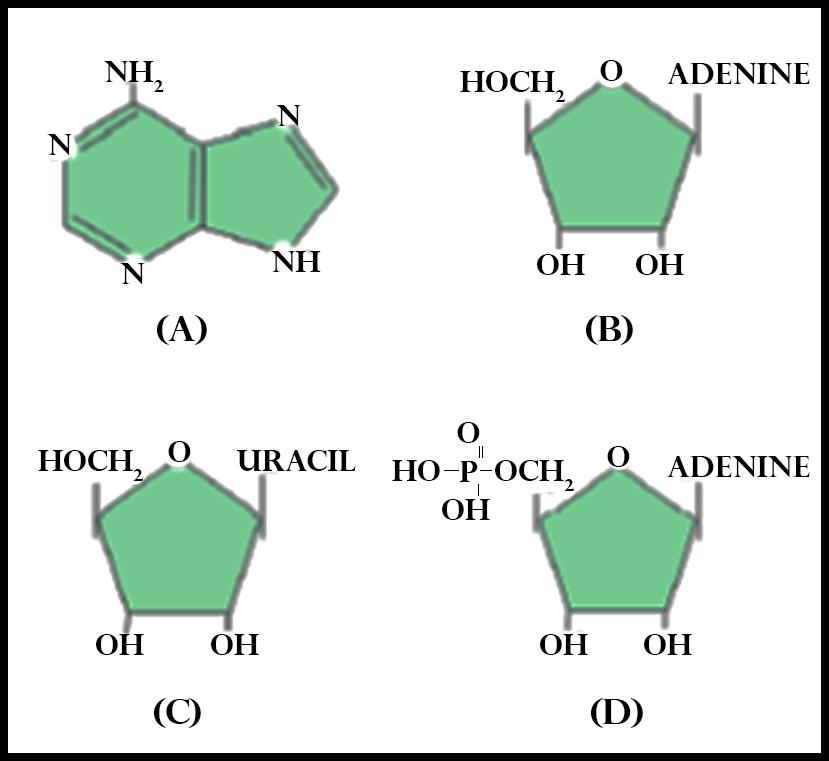
Nucleoside is

(a) A & B
(b) B & C
(c) C & D
(d) D & A

Answer
472.5k+ views
Hint: These are glycosylamines without a phosphate group. A glycosylamine is a glycosyl group attached to an amino group.
Complete step by step answer:
In the figure given in the question, option B is adenosine, and option C is uridine, both of which are nucleosides.
A nucleoside is made up of a nucleobase of a nitrogenous base and has a five-carbon sugar that is ribose or 2'-deoxyribose attached to it. In a nucleoside, the anomeric carbon forms a nexus through a glycosidic bond to the N1 of a pyrimidine such as Cytosine, Thymine (in DNA) & Uracil (in RNA) , or the N9 of a purine that is Guanine & Adenine. Some examples of nucleosides are cytidine, uridine, adenosine, guanosine, thymidine, and inosine.
Nucleosides can be produced from nucleotides anew, particularly in the liver, but they are more abundantly supplied via ingestion and digestion of nucleic acids in the diet. Nucleotidases break down nucleotides into nucleosides, such as the thymidine monophosphate into thymidine and phosphate. The nucleosides, in turn, are subsequently weakened within the lumen of the gastrointestinal system by nucleosidases into nucleobases and ribose or deoxyribose.
So, the correct answer is,’ B & C’.
Note:
- Additionally, nucleotides can be broken down inside the cell into nitrogenous bases, and deoxyribose-1-phosphate or ribose-1-phosphate.
- In medicine, several nucleotides are used as antiviral or anticancer agents. With non-canonical bases, these compounds are incorporated by the viral polymerase. These compounds are activated within the cells by being converted into nucleotides. Since charged nucleotides cannot easily cross cell membranes they are administered as nucleotides.
Complete step by step answer:
In the figure given in the question, option B is adenosine, and option C is uridine, both of which are nucleosides.
A nucleoside is made up of a nucleobase of a nitrogenous base and has a five-carbon sugar that is ribose or 2'-deoxyribose attached to it. In a nucleoside, the anomeric carbon forms a nexus through a glycosidic bond to the N1 of a pyrimidine such as Cytosine, Thymine (in DNA) & Uracil (in RNA) , or the N9 of a purine that is Guanine & Adenine. Some examples of nucleosides are cytidine, uridine, adenosine, guanosine, thymidine, and inosine.
Nucleosides can be produced from nucleotides anew, particularly in the liver, but they are more abundantly supplied via ingestion and digestion of nucleic acids in the diet. Nucleotidases break down nucleotides into nucleosides, such as the thymidine monophosphate into thymidine and phosphate. The nucleosides, in turn, are subsequently weakened within the lumen of the gastrointestinal system by nucleosidases into nucleobases and ribose or deoxyribose.
So, the correct answer is,’ B & C’.
Note:
- Additionally, nucleotides can be broken down inside the cell into nitrogenous bases, and deoxyribose-1-phosphate or ribose-1-phosphate.
- In medicine, several nucleotides are used as antiviral or anticancer agents. With non-canonical bases, these compounds are incorporated by the viral polymerase. These compounds are activated within the cells by being converted into nucleotides. Since charged nucleotides cannot easily cross cell membranes they are administered as nucleotides.
Recently Updated Pages
Using the following information to help you answer class 12 chemistry CBSE

Full Form of IASDMIPSIFSIRSPOLICE class 7 social science CBSE

In case of conflict between fundamental rights of citizens class 7 social science CBSE

Can anyone list 10 advantages and disadvantages of friction

What are the Components of Financial System?

Complete the letter given below written to your Principal class null english null

Trending doubts
Show variation of resistivity of copper as a function class 12 physics CBSE

Electrolysis of dilute H2SO4 generates H2S2O8 What class 12 chemistry CBSE

Explain with a neat labelled diagram the TS of mammalian class 12 biology CBSE

How do you convert from joules to electron volts class 12 physics CBSE

A convex lens is placed in water Its focal length A class 12 physics CBSE

Distinguish between asexual and sexual reproduction class 12 biology CBSE




